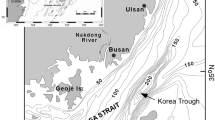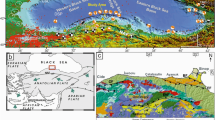Abstract
The northern East China Sea Shelf Basin consists of three depressions (the Domi, Jeju, and Socotra Depressions), separated by basement highs or rises. Reconstruction of depth-converted seismic reflection profiles from these depressions reveals that the northern East China Sea Shelf Basin experienced two phases of rifting, followed by regional subsidence. Initial rifting in the Late Cretaceous was driven by the NW–SE crustal stretching of the Eurasian plate, caused by the subduction of the Pacific plate beneath the plate margin. Major extension (~15 km) took place during the early phase of basin formation. The initial rifting was terminated by regional uplift in the Late Eocene-Early Oligocene, which was probably due to reorganization of plate boundaries. Rifting resumed in the Early Oligocene; the magnitude of extension was mild (<1 km) during this period. A second phase of uplift in the Early Miocene terminated the rifting, marking the transition to the postrift phase of regional subsidence. Up to 2,600 m of sediments and basement rock were removed by erosion during and after the second phase of uplift. An inversion in the Late Miocene interrupted the postrift subsidence, resulting in an extensive thrust-fold belt in the eastern part of the area. Subsequent erosion removed about 900 m of sediments. The regional subsidence has dominated the area since the Late Miocene.






















Similar content being viewed by others
References
Aitchison, JC, Ali JR, Davis AS (2007) When and where did India and Asia collide? J Geophys Res 112 doi:10.1029/2006JB004706
Allen MB, Macdonald DIM, Zhao X, Vincent SJ, Brouet-Menzies C (1995) Early Cenozoic two-phase extension and late Cenozoic thermal subsidence and inversion of the Bohai Basin, northern China. Mar Pet Geol 14:951–972
Bulnes M, McClay K (1999) Benefits and limitations of different 2D algorithms used in cross section restoration of inverted extensional faults: application to physical experiments. Tectonophysics 312:175–189
Casey JF, Dewey JF (1984) Initiation of subduction zones along transform and accreting plate boundaries, triple-junction evolution, and forearc spreading centres-implications for ophiolitic geology and obduction, in Ophiolites and Oceanic Lithosphere. In: Gass IG, Lippard SJ, Shelton AW (eds) Geol Soc London, Spec Pub 13, pp 269–290
Chough SK, Lee HJ, Yoon SH (2000) Marine Geology of Korean Seas. Elsevier, Amsterdam 313 p
Clark D, Pearce J, Waton P, Hulsbos R, Paton I, Rong WZ, de Smet M, Clews P, Grodynski S, Phillips C, Armstrong J, Ping GE (1994) The petroleum geology and hydrocarbon potential of the Xihu Trough, East China Sea. An integrated geophysical and geological study. Vol 1. Non-exclusive study report, Core Laboratories, Jakarta 200 p.
Clift PD, Schouten H, Draut AE (2003) A general model of arc-continent collision and subduction polarity reversal from Taiwan and Irish Caledonides. In: Larter RD, Leat PT (eds) Intra-Oceanic Subduction Systems, Tectonic and Magmatic Processes. Geol Soc, London, Spec Pub 219:81–98
Dahlstrom CDA (1969) Balanced cross sections. Can J Earth Sci 6:743–757
Engebretson DC, Cox A, Gordon RG (1985) Relative Motions Between Oceanic and Continental Plates in the Pacific Basin. Geol Soc Am, Spec Paper 206:1–59
Hall R (2002) Cenozoic geological and plate tectonic evolution of SE Asia and the SW Pacific: computer-based reconstructions, model and animations. J Asian Earth Sci 20:353–431
Jolivet L, Huchon P, Rangun C (1989) Tectonic setting of western Pacific marginal Basins. Tectonophysics 160:23–47
Keetley JT, Hill KC (2000) 3D structural modeling of the Kutubu oil fields, PNG. In: AAPG International Conference and Exhibition; Abstracts 84. Am Assoc Pet Geol 1446
KIGAM (1997) Hydrocarbon potential of the northern East China Shelf Basin I. Korea Institute of Geoscience and Mineral Resources Report KR 97(C)-17, 297 p (in Korean with English abstract)
Kong F, Lawver LA, Lee TY (2000) Evolution of the southern Taiwan-Sinzi Folded Zone and opening of the southern Okinawa trough. J Asian Earth Sci 18:325–341
Kwon YI, Boggs S (2002) Provenance interpretation of Tertiary sandstones from the Jeju Basin (NE East China Sea): A comparison of conventional petrographic and scanning cathodoluminescence techniques. Sed Geol 152:29–43
Lao Q, Zhou Z (1995) Geological History of the East China Sea. Proceedings of the Third International Conference on Asian Marine Geology, Cheju October 17.
Lee TY, Lawver LA (1995) Cenozoic plate reconstruction of Southeast Asia. Tectonophysics 251:631–645
Lee GH, Kim B, Shin KS, Sunwoo D (2006) Geologic evolution and aspects of the petroleum geology of the northern East China Sea Shelf Basin. Am Assoc Pet Geol 90(2):237–260
Letouzey J, Kimura M (1986) The Okinawa Trough: Genesis of a back-arc basin developing along a continental margin. Tectonophysics 125:209–230
Lin JY, Sibuet JC, Hsu SK (2005) Distribution of the East China Sea continental shelf basins and depths of magnetic sources. Earth Planets Space 57:1063–1072
Maruyama S, Isozaki Y, Kimura G (1997) Paleogeographic maps of the Japanese Islands: plate tectonic synthesis from 750 Ma to the present. Island Arc 6:121–142
Métivier F, Gaudemer Y, Tapponnier P, Klein M (1999) Mass accumulation rates in Asia during Cenozoic. Geophys J Int 137:280–318
Price NJ, Cosgrove JW (1990) Analysis of Geological Structures. Cambridge University Press, Cambridge 502 p
Ren J, Tamaki K, Li S, Zhang J (2002) Late Mesozoic and Cenozoic rifting and its dynamic setting in eastern China and adjacent seas. Tectonophysics 344:175–205
Sclater JG, Christie PAF (1980) Continental stretching: an explanation of the post-Mid-Cretaceous subsidence of the Central North Sea Basin. J Geophys Res 85:3711–3739
Sibuet JC, Hsu SK (2004) How was Taiwan Created? Tectonophysics 379:159–181
Sibuet JC, Letouzey J, Barbier F, Charvet J, Foucher JP, Hilde TWC, Kimura M, Ling YC, Marsett B, Muller C, Stephan JF (1987) Back arc extension in the Okinawa Trough. J Geophys Res 92:14041–14063
Stern RJ, Bloomer SH (1992) Subduction zone infancy: examples from the Eocene Izu-Bonin-Mariana and Jurassic California arcs. Geol Soc Am Bull 104:1621–1636
Sun SC (1981) The Tertiary basins of off-shore Taiwan, in Proc. 2nd ASCOPE Conf., Manila
Teng LS (1996) Orogenic collapse of the northern Taiwan Mountain belt. Geology 24:949–952
Uyeda S, Kanamori H (1979) Backarc opening and the mode of subduction. J Geophys Res 84:1049–1061
Valley Midland (2007) 2DMove5.1. Midland Valley Exploration Ltd, Glasgow
Wang S, Xie T, Wang S, Liu L (1992) Geological characteristics and petroleum potential of sedimentary basins of the china continental shelf: chapter 1: Chinese margin. Am Assoc Pet Geol Spec Vol 53:3–16
White NJ, Jackson JA, McKenzie DP (1986) The relationships between the geometry of normal faults and that of the sedimentary layers in their hanging walls. J Struct Geol 8:897–909
Woodward NB, Boyer SE, Suppe J (1989) Balanced geological cross-sections: an essential technique in geological research and exploration, Short Course in Geology vol. 6, American Geophysical Union, 132 p
Yang QL (1992) Geotectonic framework of the East China Sea. In: Watkins JS, Zhiqiang F, McMillen KJ (eds) Geology and geophysics of continental margins. Am Assoc Pet Geol Mem, vol 53, pp 17–25
Yang S, Hu S, Cai D, Feng X, Chen L, Gao L (2004) Present-day heat flow, thermal history and tectonic subsidence of the East China Sea Basin. Mar Pet Geol 21:1095–1105
Yu HS, Chow J (1996) Cenozoic basins in northern Taiwan and tectonic implications for the development of the eastern Asian continental margin. Palaeo 131:133–144
Yu Z, Wu S, Zou D, Feng D, Zhao H (2008) Seismic profiles across the middle Tan-Lu fault zone in Laizhou Bay, Bohai Sea, Eastern China. J Asian Earth Sci 33:383–394
Yun H, Yi S, Yi S, Kim JK, Byun HS, Kim GH, Park DB (1999) Biostratigraphy and paleoenvironment of the Cheju sedimentary basin-based on materials from explorations, Geobuk-1 and Okdom-1. J Paleontol Soc Korea 15:43–94
Zhou XM, Li XW (2000) Origin of late Mesozoic igneous rocks in southeastern China: implications for lithosphere subduction and underplating of mafic magmas. Tectonophysics 326:269–287
Zhou Z, Zhao J, Yin P (1989) Characteristics and tectonic evolution of the East China Sea. In: Zhu X (ed) Chinese sedimentary basins: sedimentary basins of the world 1. Elsevier, Amsterdam, pp 165–179
Acknowledgments
We would like to thank the Korea National Oil Corporation (KNOC) for permission to publish the data. We also thank the Korea Institute of Geoscience and Mineral Resources (KIGAM) for providing financial support for this study. Amy Draut and three anonymous reviewers are acknowledged with thanks for their constructive comments and suggestions. This study was supported by a grant (10-9110) from MLTM Research Fund. Kingdom Suite® (version 8.2) was used for seismic and well-log data analysis and 2DMove® (version 5.1) was used for cross-section restoration.
Author information
Authors and Affiliations
Corresponding author
Rights and permissions
About this article
Cite this article
Cukur, D., Horozal, S., Lee, G.H. et al. Structural evolution of the northern East China Sea Shelf Basin interpreted from cross-section restoration. Mar Geophys Res 32, 363–381 (2011). https://doi.org/10.1007/s11001-011-9114-4
Received:
Accepted:
Published:
Issue Date:
DOI: https://doi.org/10.1007/s11001-011-9114-4




